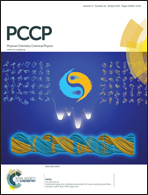A computational mechanistic investigation of hydrogen production in water using the [RhIII(dmbpy)2Cl2]+/[RuII(bpy)3]2+/ascorbic acid photocatalytic system†
Abstract
We recently reported an efficient molecular homogeneous photocatalytic system for hydrogen (H2) production in water combining [RhIII(dmbpy)2Cl2]+ (dmbpy = 4,4’-dimethyl-2,2’-bipyridine) as a H2 evolving catalyst, [RuII(bpy)3]2+ (bpy = 2,2’-bipyridine) as a photosensitizer and ascorbic acid as a sacrificial electron donor (Chem. – Eur. J., 2013, 19, 781). Herein, the possible rhodium intermediates and mechanistic pathways for H2 production with this system were investigated at DFT/B3LYP level of theory and the most probable reaction pathways were proposed. The calculations confirmed that the initial step of the mechanism is a reductive quenching of the excited state of the Ru photosensitizer by ascorbate, affording the reduced [RuII(bpy)2(bpy˙−)]+ form, which is capable, in turn, of reducing the RhIII catalyst to the distorted square planar [RhI(dmbpy)2]+ species. This two-electron reduction by [RuII(bpy)2(bpy˙−)]+ is sequential and occurs according to an ECEC mechanism which involves the release of one chloride after each one-electron reduction step of the Rh catalyst. The mechanism of disproportionation of the intermediate RhII species, much less thermodynamically favoured, cannot be barely ruled out since it could also be favoured from a kinetic point of view. The RhI catalyst reacts with H3O+ to generate the hexa-coordinated hydride [RhIII(H)(dmbpy)2(X)]n+ (X = Cl− or H2O), as the key intermediate for H2 release. The DFT study also revealed that the real source of protons for the hydride formation as well as the subsequent step of H2 evolution is H3O+ rather than ascorbic acid, even if the latter does govern the pH of the aqueous solution. Besides, the calculations have shown that H2 is preferentially released through an heterolytic mechanism by reaction of the RhIII(H) hydride and H3O+; the homolytic pathway, involving the reaction of two RhIII(H) hydrides, being clearly less favoured. In parallel to this mechanism, the reduction of the RhIII(H) hydride into the penta-coordinated species [RhII(H)(dmbpy)2]+ by [RuII(bpy)2(bpy˙−)]+ is also possible, according to the potentials of the respective species determined experimentally and this is confirmed by the calculations. From this RhII(H) species, the heterolytic and homolytic pathways are both thermodynamically favourable to produce H2 confirming that RhII(H) is as reactive as RhIII(H) towards the production of H2.
![Graphical abstract: A computational mechanistic investigation of hydrogen production in water using the [RhIII(dmbpy)2Cl2]+/[RuII(bpy)3]2+/ascorbic acid photocatalytic system](/en/Image/Get?imageInfo.ImageType=GA&imageInfo.ImageIdentifier.ManuscriptID=C4CP04949G&imageInfo.ImageIdentifier.Year=2015)

 Please wait while we load your content...
Please wait while we load your content...